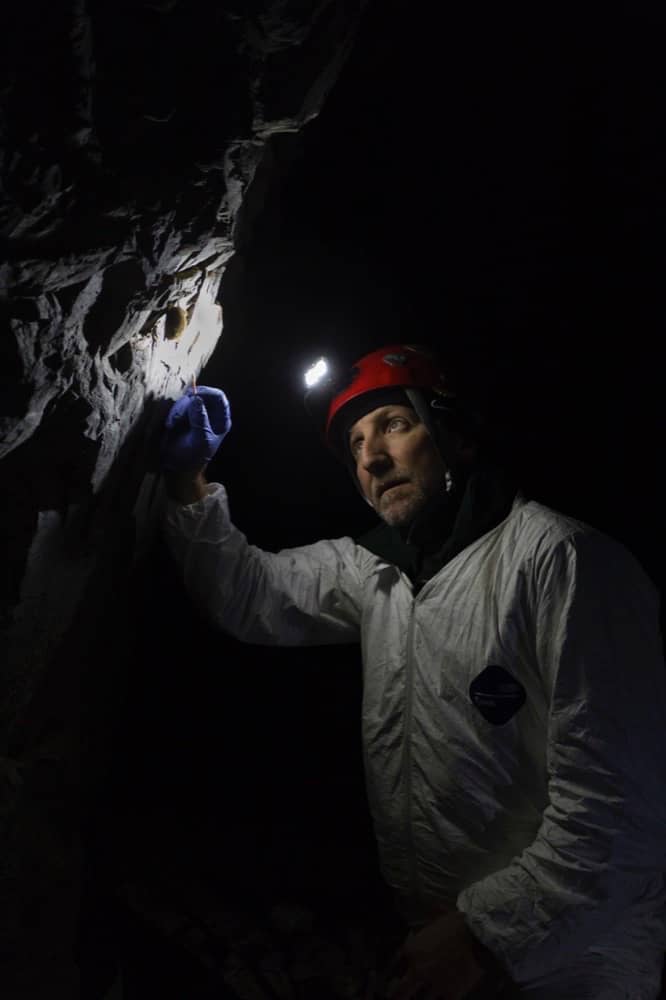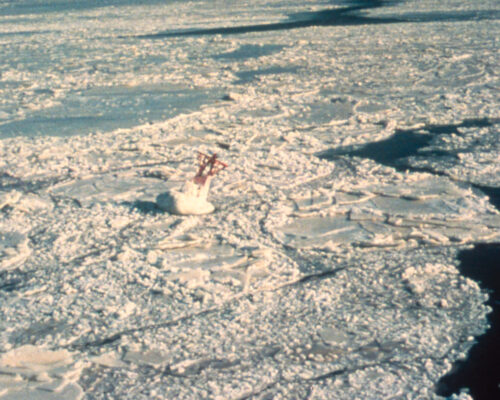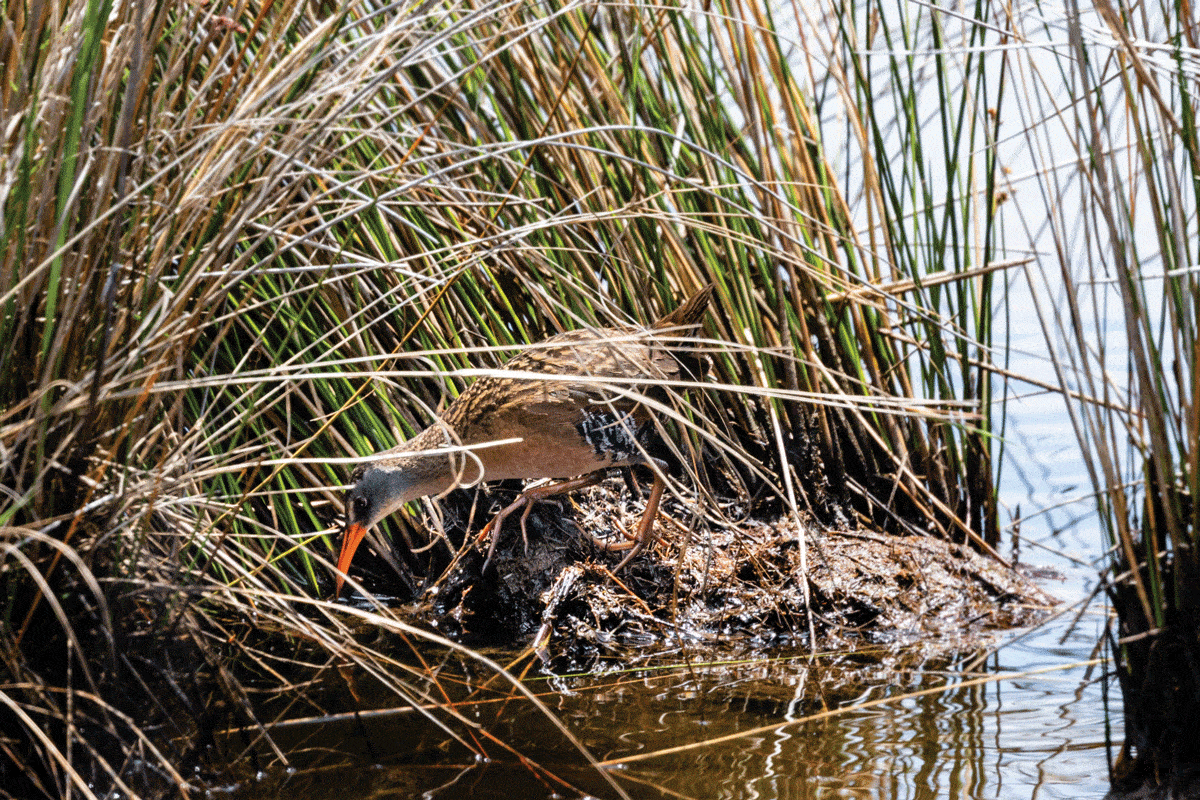Spelunking for science with Maryland’s bat man.
Sliding through tight rocky crevices, Dan Feller moves with relative ease as he twists his body at every turn like a contortionist. Rappelling by rope downward into the dark labyrinth and crowned with a headlamp-covered helmet, he’s enthusiastic about this difficult sport. Feller is a talented caver and biologist.
He is also Maryland’s resident “bat man.” Today, he dons his white Tyvek coverall suit to survey bats in hibernacula—their winter dwellings.
Feller’s fascination with the world of caves began as a young boy. “It was a sign for Meramec Caverns that I saw a sign on vacation with my parents, and I cried when they told me we couldn’t stop,” he says. “I had awesome parents; they turned around, we went in. I still have the stamped coin today from that visit.” The almost otherworldly fauna of caves, like woodrats and blind invertebrates with no pigment, led him to biology. “My primary interests as an ecologist were cave-adapted invertebrates and small mammals, so bats joined those two niches.”
Our excursion took place before the COVID-19 pandemic. Today, any bat research that requires the handling of bats or entering caves is on hold in many states, including Maryland. Native bats are not the ones suspected to be responsible for the pandemic, but they could be threatened by it. Research is underway to investigate the possibility of infecting native bats with coronavirus, and the spread of the virus from humans to bat populations.
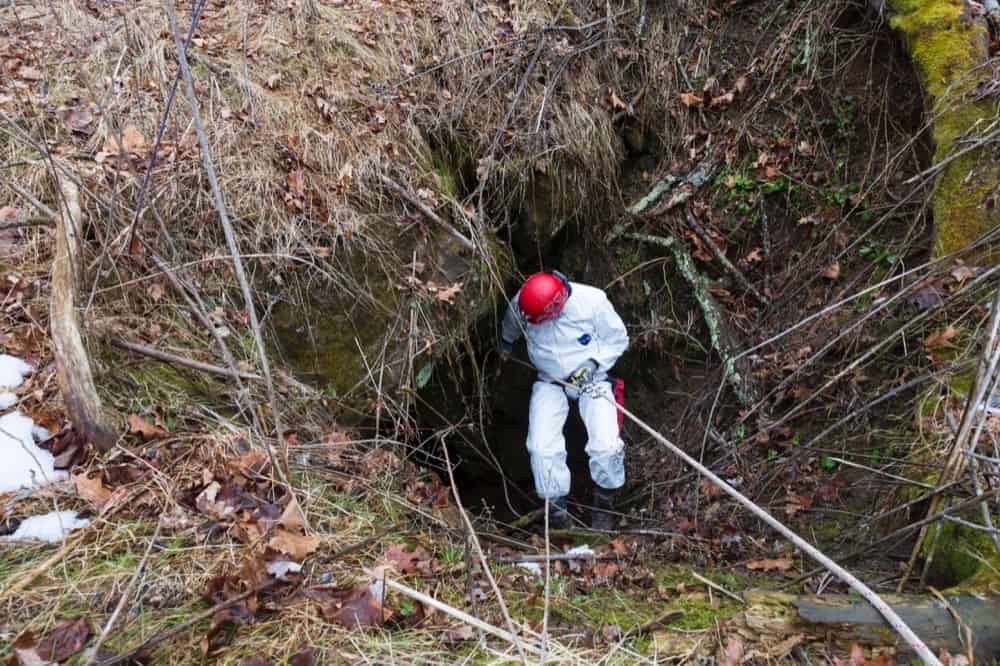
Maryland is home to 10 species of bat. Four of those, including the eastern red bat, are tree bats—which, as the name suggests, roost in trees and usually migrate southward to avoid the frigid temperatures of winter. The other six are cave bats, and the subject of Feller’s survey. These bats, such as the big brown bat and tricolored bat, hibernate in caves and mines during the winter months due to the mild temperatures and high humidity. It is within these ancient formations that the bats are most vulnerable to the threat of white-nose syndrome (WNS), a disease caused by a fungus (Pseudogymnoascus destructans or simply Pd) introduced from Europe and first discovered in a cave near Albany, New York in 2006.
By 2010, the disease had spread to Maryland. It was confirmed in an Allegany County cave near Cumberland, and later discovered in multiple caves and abandoned mines and tunnels in the western portion of the state. Its spread has been very rapid. WNS is now confirmed in 33 states and seven Canadian provinces.
It’s a nasty disease that first attacks the skin of bats when they are hibernating in caves. As the fungus progresses, the bats become more active and engage in odd behaviors such as flying outside during daylight hours in the midst of winter, when they should stay in the hibernacula. This causes the depletion of stored fat they need to survive the season. Perhaps the most infamous symptom is the white powder or fuzzy looking substance that is found growing on the skin and muzzle of affected bats, evidence of the fungus visible to the naked eye. This awful disease is now responsible for the deaths of more than 5.7 million bats in the eastern United States, and there is no cure. Caves that once hosted thousands of bats are now empty.
A 30 plus-year veteran of the Maryland Department of Natural Resources, Feller has witnessed the devastation. “Hibernacula were littered with dead or dying bats often covered with the white fungal hyphae characteristic of WNS,” he says of the early years after its arrival. Feller initiated the state’s annual bat hibernacula monitoring program and was able to confirm the extent of the disease’s impact.
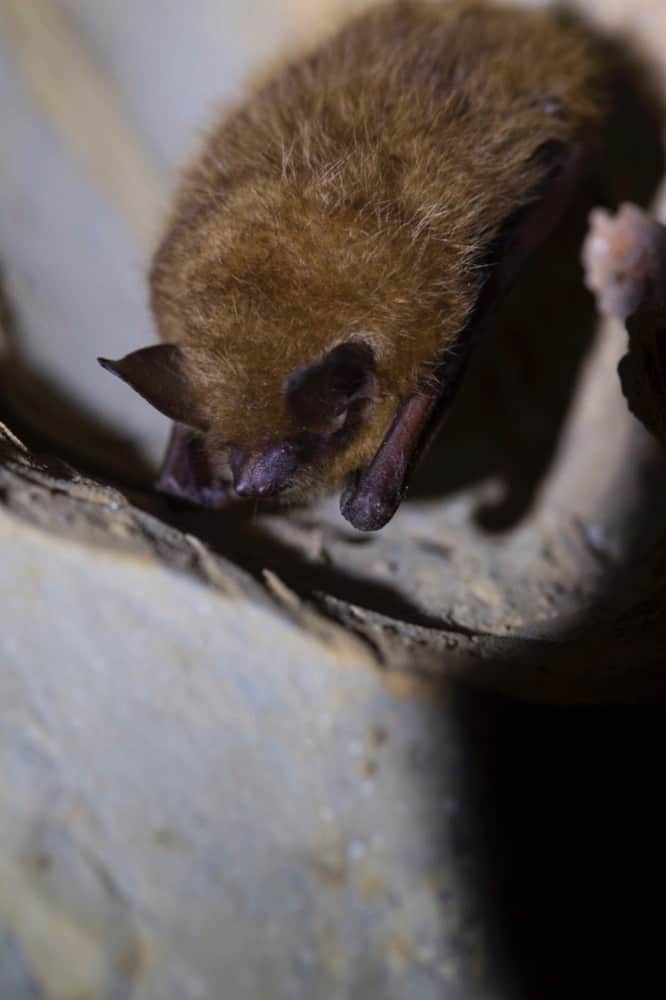
White-nose syndrome “has wreaked havoc among cave hibernating bats, reducing populations by more than 90 percent for most species. Many of our most common species, such as the little brown bat, tricolored bat, and northern long-eared bat, have become remarkably rare. The latter is now listed as threatened in Maryland and nationally as a result of WNS,” he laments. Other caves where WNS has been documented experienced 100 percent mortality in hibernating bats. Bats are the only species susceptible to this disease, and it causes no ill effect to humans.
So how did it spread, and spread so rapidly? Its introduction to New York was most likely from humans who had been caving in Europe. The fungus is easily spread if left on clothing and gear that has not been decontaminated. In 2016 the fungus appeared in Washington State. The next closest site contaminated with the fungus, though, was in the Midwest. The most plausible explanation is that it arrived via humans entering the cave who had unknowingly carried the fungus on their gear. (This is why Feller changes coveralls between caves.) Fast forward to the present: It is believed that the fungus is mostly spread from bat-to-bat contact. Vulnerable species of cave bats hibernate together in close clusters, from only a few to very massive numbers, essentially acting as a petri dish for the fungus to grow.
It’s an unfortunate reality for such remarkable animals. Besides the bat’s uniqueness as the only mammal capable of flight, they also echolocate like aquatic mammals, making them adept at navigating and hunting insects in total darkness. And let’s not forget bat biodiversity, which is simply incredible. Some migrate, others hibernate. Vampire bats feed on blood. They also serve multiple notable ecological niches. Some bats pollinate plants while some fruit-eating bats are responsible for seed dispersal. They also eat a lot of insects—so much that it is estimated they provide billions of dollars worth of insect control service to farmers in the U.S. alone. Bats are essentially nature’s perfect insect control team.
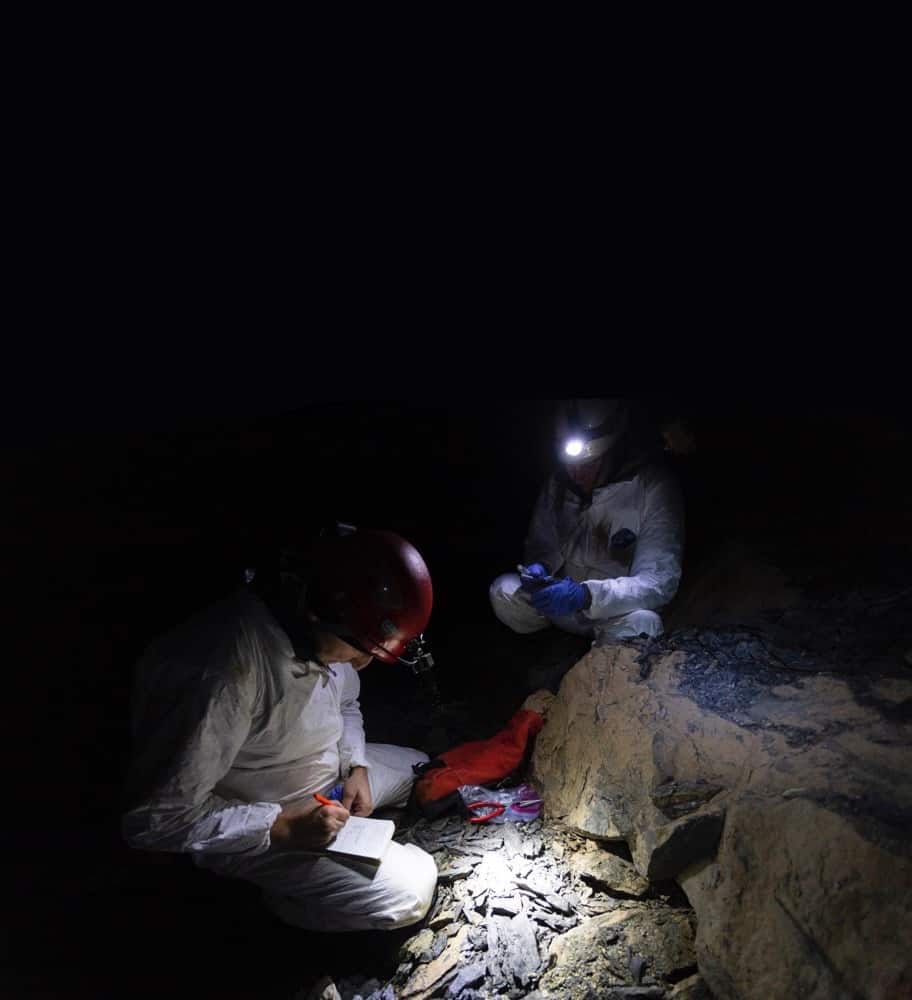
Feller conducts his surveys in western Maryland, within the Appalachian region of the Chesapeake Bay Watershed. He is currently involved with a continental-scale study investigating WNS transmission and surveillance to better understand the disease and combat its spread. Weaving through the cave in an almost poetic fashion, he meticulously scans a wall. If bats are located, he makes note of the species, the cluster size, and how close they are. He also records details of the cave’s microclimate, as there are multiple studies underway that are investigating links between the pathogen’s spread and the hibernaculum microclimates.
On this cave visit, he locates a bat within reaching distance, giving him the opportunity to swab it. He does not find any evidence of the infamous white fuzz, the obvious superficial sign, on this bat. But that doesn’t mean the fungus is not present. “In recent years, remaining diminished bat populations in hibernation rarely show obvious signs of the fungus as it’s taken on a more diminutive form but may still be observed fluorescing under UV light. The fungus does not disappear even though all the bats at a site have perished; it continues to persist in the cave environment on other organic material,” he adds.
This big brown bat briefly awakens from its torpor state and emits a slight hiss. Once Feller completes a swab of its muzzle, he places the sample in a vial and records his notes. The bat is back in hibernation within minutes of the interruption.
A growing number of biologists and scientists are working on combatting the WNS invasion. At a January 2020 Northeast Bat Working Group meeting, representatives from federal and state agencies (including Feller) as well as biologists affiliated with universities, conservation organizations, and even private consultants gathered to make presentations, share current data, and discuss methodologies and management practices to better protect bats. Current research into potential treatments and curbing the growth of the fungus was presented. Of particular note were the preliminary findings in a controlled study, where researchers from Temple University, Lock Haven University, and the Pennsylvania Game Commission observed that the growth of the fungus is slowed on bat wings at colder sites in a hibernaculum. As this infliction knows no borders, it is through collaboration and the sharing of methods that researchers hope to gain traction on the disease.
If there is a silver lining regarding the plight of hibernating bats, it is that there appears to be a growing appreciation of these fascinating mammals. “WNS has created a new focus on bats, with research documenting their importance and the public gaining interest and acceptance of the once-maligned creatures,” says Feller. This includes compliance in not entering protected caves, of which there are many in Maryland. “Conservation efforts have stepped up management efforts such as gating caves to reduce disturbance during hibernation and creating more bat-friendly forest management practices,” he adds.
So, how can you help bats? First and foremost, do not enter a cave that is closed off. It is dangerous to go into a cave without the proper gear. The cave is closed for a reason, most likely to protect bats. (In fact, the U.S. Fish & Wildlife Service requests that cavers refrain from caving in all WNS-affected states. Cavers should also not cave anywhere during the bat hibernation months, which run September through May.) States hit hardest by WNS are closing more and more caves to protect the bats.
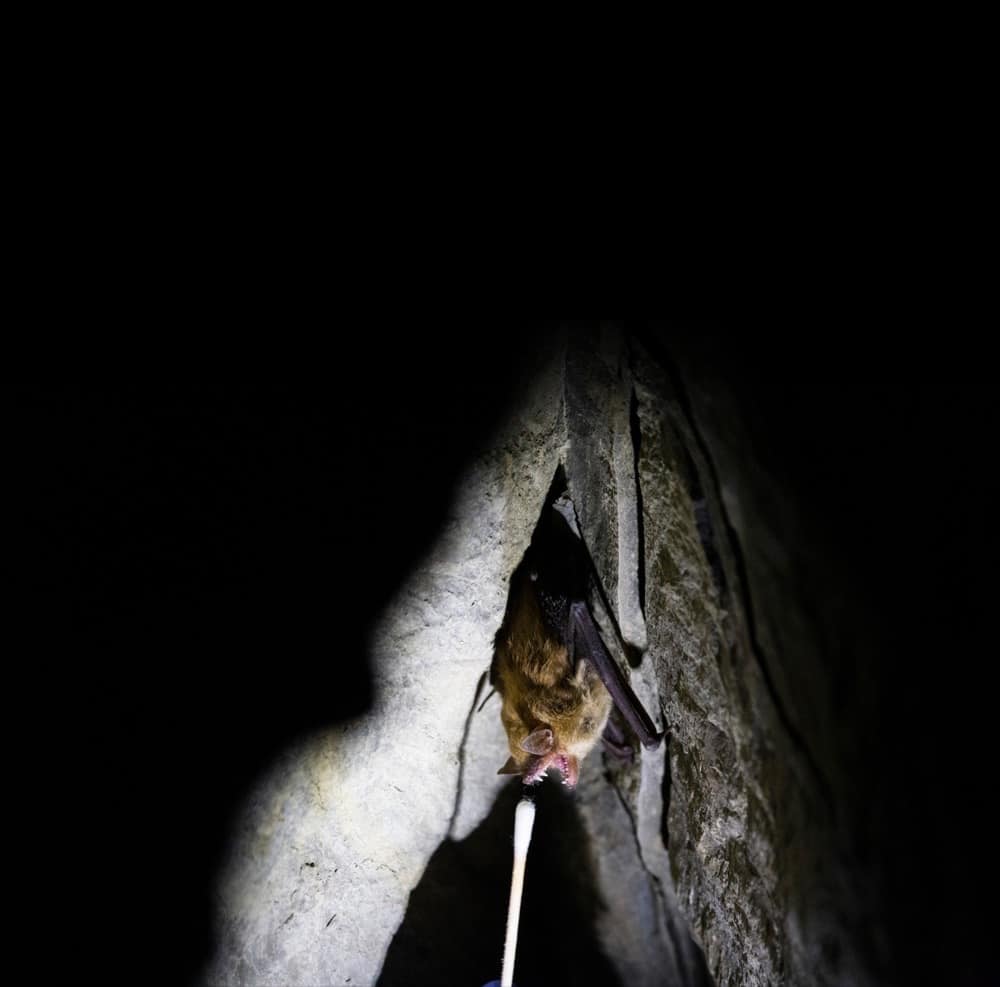
Additionally, it is critical to decontaminate your gear after caving. The fungus is quite resilient and can survive on clothes, boots, gear, bags, and even research tools for a long time. If you observe a bat outside during the winter months, make a note of when and where, and contact the Department of Natural Resources Wildlife and Heritage Division at 410-260-8540, or Daniel Feller via the DNR Appalachian lab at 301-689-7202.
In the chill of the fresh air, I walk with Feller down a path as our eyes readjust to the daylight. He points to a small rocky opening at foot level that leads to a cave. “That one requires belly crawling for about 150 feet before you can stand,” he says. “We don’t have to do that one today.” h

